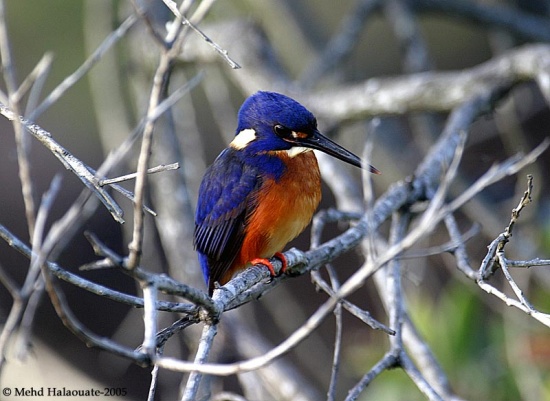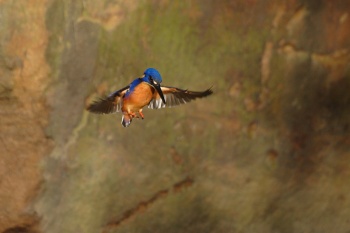(Added Category video) |
(Some minor additions. References updated) |
||
| Line 3: | Line 3: | ||
''Alcedo azurea'' | ''Alcedo azurea'' | ||
==Identification== | ==Identification== | ||
| − | + | 18 cm (7 in)<br /> | |
| − | *Deep blue to azure | + | *Deep blue to azure upperparts |
*Large white to buff spot on side of neck and throat | *Large white to buff spot on side of neck and throat | ||
*Rufous-buff with some blue-violet streaks on breast and flanks | *Rufous-buff with some blue-violet streaks on breast and flanks | ||
*Red feet | *Red feet | ||
| − | * | + | *Rufous [[Topography#Heads|loral]] spot |
==Distribution== | ==Distribution== | ||
Found throughout [[New Guinea]] including nearby islands, also the [[Moluccas]], [[Australia]] and [[Tasmania]]. | Found throughout [[New Guinea]] including nearby islands, also the [[Moluccas]], [[Australia]] and [[Tasmania]]. | ||
| Line 14: | Line 14: | ||
==Taxonomy== | ==Taxonomy== | ||
This species is included in genus [[:Category:Alcedo|Alcedo]] by some authorities. | This species is included in genus [[:Category:Alcedo|Alcedo]] by some authorities. | ||
| − | ====Subspecies<sup>[[#References|[1]]]</sup> | + | ====Subspecies==== |
| + | There are 8 subspecies<sup>[[#References|[1]]]</sup>: | ||
*''C. a. affinis'': | *''C. a. affinis'': | ||
:*Northern [[Moluccas]] (Morotai, Halmahera and Bacan) | :*Northern [[Moluccas]] (Morotai, Halmahera and Bacan) | ||
| Line 32: | Line 33: | ||
:*[[Tasmania]] | :*[[Tasmania]] | ||
==Habitat== | ==Habitat== | ||
| − | Always spotted near water of some kind; ponds, rivers, lakes and mangroves. | + | Always spotted near water of some kind; ponds, rivers, lakes and mangroves, estuaries and coastal waters. |
==Behaviour== | ==Behaviour== | ||
====Diet==== | ====Diet==== | ||
| − | The diet consists mostly of fish and insects. | + | The diet consists mostly of small fish and insects. |
====Breeding==== | ====Breeding==== | ||
It nests in a chamber up to 1 metre long in an earthen creek bank. 5-7 white, rounded, glossy eggs are laid. | It nests in a chamber up to 1 metre long in an earthen creek bank. 5-7 white, rounded, glossy eggs are laid. | ||
| Line 41: | Line 42: | ||
The voice is a high-pitched, shrill, ''pseet-pseet''. | The voice is a high-pitched, shrill, ''pseet-pseet''. | ||
==References== | ==References== | ||
| − | #{{Ref- | + | #{{Ref-Clements6thAug15}}#Handbook of the Birds of the World Alive (retrieved September 2015) |
| + | #Wikipedia | ||
{{ref}} | {{ref}} | ||
==External Links== | ==External Links== | ||
Revision as of 21:08, 3 September 2015
- Ceyx azurea
Alcedo azurea
Identification
18 cm (7 in)
- Deep blue to azure upperparts
- Large white to buff spot on side of neck and throat
- Rufous-buff with some blue-violet streaks on breast and flanks
- Red feet
- Rufous loral spot
Distribution
Found throughout New Guinea including nearby islands, also the Moluccas, Australia and Tasmania.
Taxonomy
This species is included in genus Alcedo by some authorities.
Subspecies
There are 8 subspecies[1]:
- C. a. affinis:
- Northern Moluccas (Morotai, Halmahera and Bacan)
- C. a. wallaceanus:
- Aru Islands
- C. a. lessonii:
- Lowlands of New Guinea, western Papuan islands and Fergusson Island
- C. a. ochrogaster:
- Northern New Guinea and islands in Geelvink Bay
- C. a. yamdenae:
- Tanimbar Islands (southern Banda Sea)
- C. a. ruficollaris:
- Coastal northern Australia and major offshore outlying islands
- C. a. azurea:
- Coastal eastern and south-eastern Australia
- C. a. diemenensis:
Habitat
Always spotted near water of some kind; ponds, rivers, lakes and mangroves, estuaries and coastal waters.
Behaviour
Diet
The diet consists mostly of small fish and insects.
Breeding
It nests in a chamber up to 1 metre long in an earthen creek bank. 5-7 white, rounded, glossy eggs are laid.
Vocalisation
The voice is a high-pitched, shrill, pseet-pseet.
References
- Clements, J. F., T. S. Schulenberg, M. J. Iliff, D. Roberson, T. A. Fredericks, B. L. Sullivan, and C. L. Wood. 2015. The eBird/Clements checklist of birds of the world: v2015, with updates to August 2015. Downloaded from http://www.birds.cornell.edu/clementschecklist/download/
- Handbook of the Birds of the World Alive (retrieved September 2015)
- Wikipedia
Recommended Citation
- BirdForum Opus contributors. (2024) Azure Kingfisher. In: BirdForum, the forum for wild birds and birding. Retrieved 10 May 2024 from https://www.birdforum.net/opus/Azure_Kingfisher
External Links





